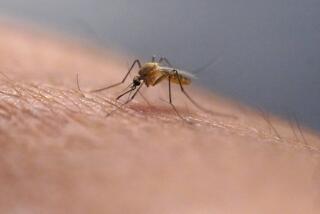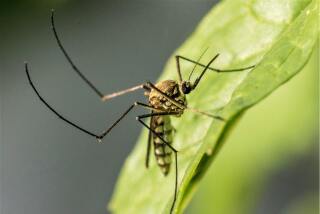Rabid bat found in picnic area of Griffith Park
A bat found April 5 at the popular Crystal Springs picnic area in Griffith Park has tested positive for rabies, and county health officials are asking that anyone who may have touched the animal contact a doctor for possible anti-rabies treatment.
Parents should ask their children if they noticed any bats while playing in the park, said Dr. Jonathan E. Fielding, the Los Angeles County director of public health.
The virus is usually transmitted by a bite, but bat bites can seem superficial and are not always easily noticed. In rare instances a person can be exposed to rabies just through contact with infectious saliva.
“If untreated, rabies is nearly always fatal, so we want people to err on the side of caution,” Fielding said.
Anti-rabies shots, he added, are not the painful ordeal that they once were.
Picnickers noticed the bat, which was alive but on the ground, and called a park ranger, who turned it in to be euthanized and tested.
Any mammal can get rabies, but with the widespread vaccination of pets and other domestic animals, the main carriers are raccoons, bats, skunks, foxes and other wild animals. Public health experts warn against touching or handling any wild or unfamiliar animal.
Rabies is an infectious viral disease that affects the central nervous system. It can take months for the first flu-like symptoms to appear and progress to confusion, hallucinations and other neurological signs. Death usually follows within days.
Rabies deaths in the United States have declined dramatically with the introduction of animal vaccines and anti-rabies treatments, according to the federal Centers for Disease Control and Prevention. Today there are one or two deaths a year, usually among people who didn’t realized they had been exposed.
There have been two deaths in Los Angeles County in recent years, said Fielding, and in both cases the virus was contracted outside of the country.
But public health officials are renewing warnings against handling bats and other wild animals because in 2007 the county found rabies in 24 bats. Over the five previous years, on average, the county had found rabies in about 10 bats a year.
Some experts theorize that Los Angeles and other Western cities are seeing more bats overall because the region’s long-running drought is forcing bats to search for water.
“That’s very possible,” said Merlin D. Tuttle, a biologist and president of Bat Conservation International, based in Austin, Texas.
“We have a severe problem for bats in the Southwest getting enough drinking water. A large proportion of open natural water sites have been lost over time,” Tuttle said.
Many bats can’t drink unless they have fairly substantial “swoop” zones -- open bodies of water that allow them to drink in flight, Tuttle said. Reservoirs and swimming pools can draw bats because they make good open-water drinking sites.
But an increase in bats is no reason for alarm, Tuttle said. A million and a half bats live under a bridge in downtown Austin, and in 25 years no one who has gone out to watch them emerge each evening has been harmed.
“We just put up signs telling people if bats are on the ground, don’t handle them,” Tuttle said. “All they need to do is leave the bats alone, and bats are happy to return the favor.”
To ask a public health doctor’s advice on the need for treatment call (213) 974-1234. To report sick or dead bats or animal bites call (877) 747-2243.
--
More to Read
Sign up for Essential California
The most important California stories and recommendations in your inbox every morning.
You may occasionally receive promotional content from the Los Angeles Times.









